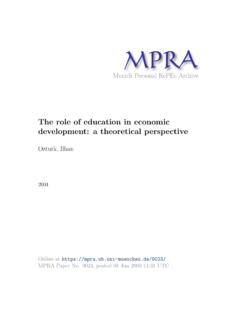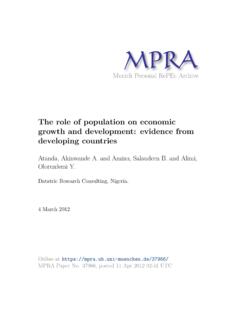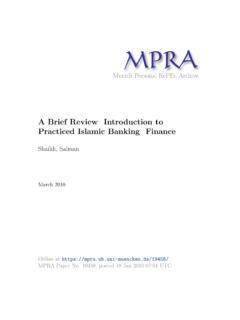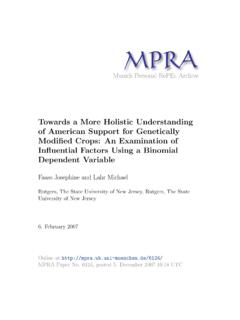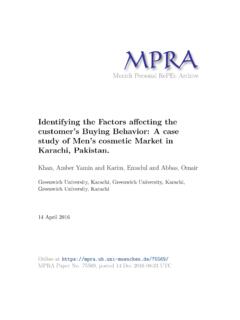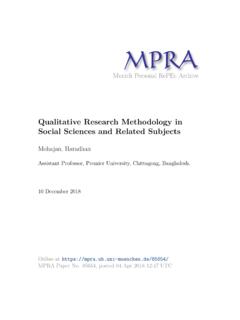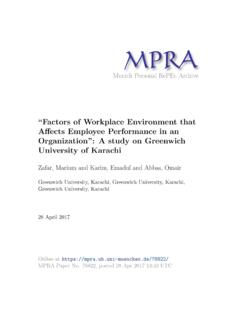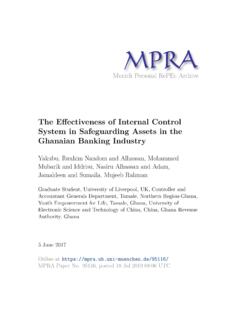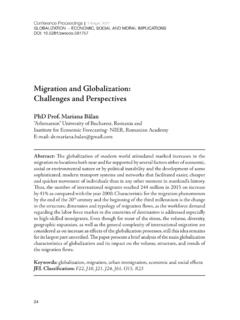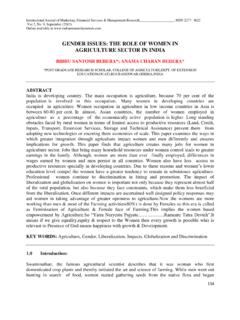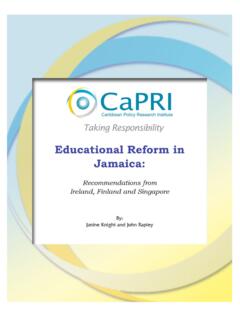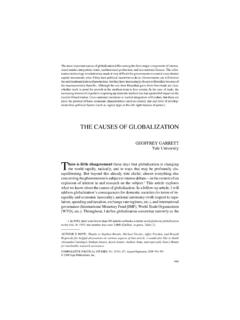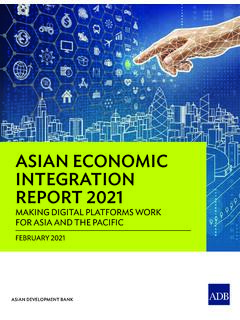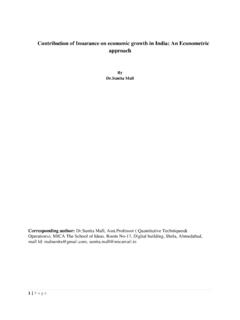Transcription of The Impact of Domestic Investment on Economic Growth: …
1 Munich Personal RePEc ArchiveThe Impact of Domestic Investment onEconomic Growth: New Evidence fromMalaysiaBakari, SayefDepartment of Economic Science, LIEI, Faculty of EconomicSciences and Management of Tunis (FSEGT), University of Tunis ElManar, Tunisia1 January 2017 Online Paper No. 79436, posted 30 May 2017 04:34 UTC1 The Impact of Domestic Investment on Economic Growth: New Evidence from Malaysia Sayef Bakari Department of Economic Science, LIEI, Faculty of Economic Sciences and Management of Tunis (FSEGT), University of Tunis El Manar, Tunisia. ABSTRACT: This paper investigates the relationship between Domestic Investment and Economic growth in Malaysia. In order to achieve this purpose, annual data for the periods between 1960 and 2015 was tested by using Correlation analysis, Johansen co-integration analysis of Vector Error Correction Model and the Granger-Causality tests.
2 According to the result of the analysis, it was determined that there is a positive effect of Domestic Investment , exports and labors on Economic growth in the long run term, however, there is no relationship between Domestic Investment and Economic growth in the short run term. These results provide en evidence that Domestic Investment , exports and labors are seen as a source of Economic growth in Malaysia JEL Classification: C13, E22. KEY WORDS: Domestic Investment , Economic Growth, Correlation, Cointegration, VECM and Causality, Malaysia. I. INTRODUCTION Domestic Investment is one of the most important Economic processes that countries attach great importance to as one of the most important components of the Economic growth of the country and the main engine of the Economic cycle.
3 Also, Domestic Investment has a relationship with various Economic variables, which made countries seek to guide the 2 Investment decision and create the appropriate climate for Economic development and maximizing wealth, thus making researchers in the economy pay great attention to study Investment in terms of Economic , financial and accounting. Respect of Domestic Investment at the level of the national economy, capital spending on new projects in the sectors of public utilities and infrastructure such as incision main and branch roads projects and extensions of water and sewerage connections and create urban plans and construction projects, housing and extensions of electricity and power generation, as well as social development in the areas of education, health and communication projects, projects as well to projects that relate to Economic activity for the production of goods and services in the production and service sectors such as industry, agriculture, housing, health.
4 Education and tourism. Obtainable literature, including recent extensions of the neo-classical growth model as well as the theories of endogenous growth has emphasized the role of Domestic Investment in Economic growth. Among these studies we can cite Kormendi and Meguire (1985); Romer (1986); Lucas (1988); Grier and Tullock (1989); Barro (1991); Levine and Renelt (1991); Rebelo (1991); Mankiw, Romer, and Weil (1992); Fischer (1993) and Barro and Sala-i-Martin (1999). The Malaysian experience is one of development experiences worthy of attention and study of the great achievements that could have benefited the developing countries in general and the Arab countries in particular in order to rise from underdevelopment, stagnation and subordination.
5 Malaysia is a highly developed Islamic country that, over the past four decades, has made tremendous strides in human and Economic development. It has become the first industrial country in the Islamic world. It is also the first in the field of exports and imports in Southeast Asia. National economy, industry, agriculture, minerals, oil and tourism, and made progress in tackling poverty, unemployment, corruption and reducing indebtedness to large levels. Malaysia has benefited from greater Economic openness to the outside through its integration into the economies of globalization while maintaining the pillars of the development of its national economy, and we see the progress made clear by transforming it from a country that relies mainly on agriculture to a country of origin for industrial and technical goods, especially in the electrical and electronic industries (2001), which monitored the most important technology exporting countries in the world.
6 Malaysia ranked ninth, ahead of both Italy and Sweden, and it was a very successful experience in the face of the Economic crisis (1997), which faced the countries of Southeast Asia as a whole the best evidence of the successful program carried out through their commitment to implement a national plan of action imposed by tight limits on monetary policy and gave the Central Bank wide powers to implement a contingency plan to face the 3 flight of capital and bring foreign exchange to And Malaysia was able to break its financial crisis in just two years. In particular, this work tries to empirically find an answer for the question of whether there is a nexus between Domestic Investment and Economic growth in Malaysia, to achieve this objective the paper is structured as follows.
7 In section 2, we present the review literature concerning the nexus between Domestic Investment and Economic growth. Secondly, we discuss the Methodology Model Specification and data used in this study in Section 3. Thirdly, Section 4 presents the empirical results as well as the analysis of the findings. Finally, Section 5 is dedicated to our conclusion. II. REVIEW LITERATURE Several empirical studies which investigated the relationship between Domestic Investment and Economic growth found that, fixed capital formation determine the rate of future Economic growth. These studies include: Table 1: Studies related to the relationship between Domestic Investment and Economic growth NO Authors Countries Periods Econometric techniques Keys Findings 1 COMBEY and al (2016) UEMOA 1995-2014 Cointegration analysis GDP Domestic Investment 2 Debi Prasad Bal and al (2016) India 1970-2012 VECM Domestic Investment GDP 3 Montassar Kahia and al (2016) MENA 1980 2012 Cointegration analysis Domestic Investment GDP 4 Rami Hodrab and al(2016) MENA 1995-2013 Granger causality tests Domestic Investment GDP 5 P Pegkas and al (2016) Greece 1970-2012 Cointegration analysis Domestic Investment GDP VAR Granger causality tests 6 Hatem H.
8 A. A and al (2016) Arabia Saudi 1980-2014 Cointegration analysis Domestic Investment GDP ARDL 7 Mahmoud and al(2016) MENA 1977-2013 Tobit Domestic Investment GDP OLS 8 Manamba EPAPHRA and al(2016) Tanzania 1970-2014 Cointegration analysis Domestic Investment GDP Granger causality tests 9 Masoud Albiman Md and al(2016) Malaysia 1967-2010 Cointegration analysis GDP Domestic Investment Granger causality tests 10 Matiur Rahman and al(2016) Bangladesh 1972-2012 Cointegration analysis Domestic Investment GDP VECM 11 Nurudeen Abu and al (2016) Sub-Saharan Africa 1981 -2011 VAR Domestic Investment GDP Granger causality tests 12 Bakari Sayef (2016) Egypt: 1965-2015 Cointegration analysis Domestic Investment GDP 4 Granger causality tests 13 Bakari Sayef (2016 ) Japan 1970-2015 Correlation Analysis Domestic Investment GDP OLS 14 Omosebi Ayeomoni and al(2016) Nigeria 1986-2014 ARDL Domestic Investment GDP 15 Bakari Sayef (2017) Canada 1990-2015 Cointegration analysis Domestic Investment GDP Granger causality tests 16 Najid Ahmad and al(2017) Iran 1971 -2011 Cointegration analysis Domestic Investment GDP Granger causality tests III.
9 Data, methodology and model specification 1. The Data: The analysis used in this study cover annual time series of 1960 to 2015 or 56 observations which should be sufficient to capture the short run and long run correlation between Export, Labor, Fixed Formation Capital and Economic growth in the model. All data set are taken from World Development Indicators 2016. 2. Methodology Since our study uses variables whose data are in the form of a time series, it is necessary to ascertain their stationary, hence the need to carry out tests of stationary to determine the degree of integration of Variables, among the various tests of verification of stationary that exist.
10 Our study retains the unit root tests ADF and PP. If the variables are all integrated in level, we apply an estimate based on a linear regression. On the other hand, if the variables are all integrated into the first difference, our estimates are based on an estimate of the VAR model. When the variables are integrated in the first difference we will examine and determine the cointegration between the variables, if the cointegration test indicates the absence of cointegration relation, we will use the model VAR. If the cointegration test indicates the presence of a cointegration relation between the different variables studied, the model VECM will be used.
